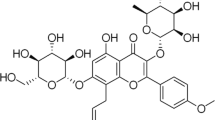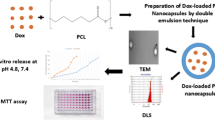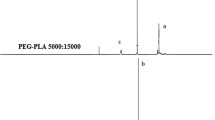ABSTRACT
Purpose
To evaluate the in vitro and in vivo pancreatic anticancer activity of a nano-sized formulation based on novel polyallylamine grafted with 5% mole cholesteryl pendant groups (CH5-PAA).
Methods
Insoluble novel anticancer drug, Bisnaphthalimidopropyldiaaminooctane (BNIPDaoct), was loaded into CH5-PAA polymeric self-assemblies by probe sonication. Hydrodynamic diameters and polydispersity index measurements were determined by photon correlation spectroscopy. The in vitro cytotoxicity evaluation of the formulation was carried out by the sulforhodamine B dye assay with human pancreatic adenocarcinoma BxPC-3 cells, while for the in vivo study, Xenograff mice were used. In vitro apoptotic cell death from the drug formulation was confirmed by flow cytometric analysis.
Results
The aqueous polymer-drug formulation had a mean hydrodynamic size of 183 nm. The drug aqueous solubility was increased from negligible concentration to 0.3 mg mL−1. CH5-PAA polymer alone did not exhibit cytotoxicity, but the new polymer-drug formulation showed potent in vitro and in vivo anticancer activity. The mode of cell death in the in vitro study was confirmed to be apoptotic. The in vivo results revealed that the CH5-PAA alone did not have any anti-proliferative effect, but the CH5-PAA-drug formulation exhibited similar tumour reduction efficacy as the commercial drug, gemcitabine.
Conclusions
The proposed formulation shows potential as pancreatic cancer therapeutics.








Similar content being viewed by others
REFERENCES
Lowenfels AB, Maisonneuve P. Epidemiology and prevention of pancreatic cancer. Jpn J Clin Oncol. 2004;34:238–44.
Sarkar FH, Li Y, Wang Z, Kong D. Pancreatic cancer stem cells and EMT in drug resistance and metastasis. Minerva Chir. 2009;64:489–500.
Jemal A, Thomas A, Murray T, Thun M. Cancer statistics. Cancer J Clin. 2002;52:23–47.
Sa Cunha A, Rault A, Laurent C, Adhoute X, Vendrely V, Bellannee G, et al. Surgical resection after radiochemotherapy in patients with unresectable adenocarcinoma of the pancreas. J Am Coll Surg. 2005;201(3):359–65.
Lockhart AC, Rothenberg ML, Berlin JD. Treatment for pancreatic cancer: current therapy and continued progress. Gastroenterology. 2005;128:1642–54.
Novarino I, Chiappin GF, Bertelli A, Heouaine G, Ritorto A, Addeo G, et al. Phase II study of cisplatin, gemcitabine and 5-fluorouracil in advanced pancreatic cancer. Ann Oncol. 2004;15:474–7.
Oliveira J, Ralton L, Tavares J, Codeiro-da-Silva A, Bestwick C, McPherson A, et al. The synthesis and the in vitro cytotoxicity studies of bisnaphthalimidoproply polyamine derivatives against colon cancer cells and parasite Leishmania infantum. Bioorganic Med Chem. 2007;15:541–5.
Dance A-M, Ralton L, Fuller Z, Milne L, Duthie S, Bestwick C, et al. Synthesis and biological activities of bisnaphthalimido polyamines derivatives: cytotoxicity, DNA binding, DNA damage and drug localization in breast cancer MCF 7 cells. Biochem Pharmacol. 2005;69:19–27.
Kong Thoo Lin P, Dance A-M, Bestwick C, Milne L. The biological activities of new polyamine derivatives as potential therapeutic agents. Biochem Soc Trans. 2003;31:407–10.
Ralton L, Bestwick CS, Milne L, Duthie S, Kong Thoo Lin P. The study of Bisnaphthalimidopropyl Spermidine and Spernine on DNA damage and repair within Colon Carcinoma Cells. Chem-Biol Interact. 2009;177:1–6.
Brana MF, Ramos A. Naphthalimides as anti-cancer agents: synthesis and biological activity. Curr Med Chem Anti-Canc Agents. 2001;1:237–55.
Kong Thoo Lin P, Pavlov VA. The synthesis and in vitro cytotoxic studies of novel Bis-naphthalimidopropyl polyamine derivatives. Bioorg Med Chem Lett. 2000;10:1609–12.
Thompson C, Ding C, Qu X, Yang Z, Uchegbu IF, Tetley L, et al. The effect of polymer architecture on the nano self-assemblies based on novel comb-shaped amphiphilic poly(allylamine). Colloid Polym Sci. 2008;286:1511–26.
Qiu L, Zheng C, Jin Y, Zhu K. Polymeric micelles as nanocarriers for drug delivery. Expert Opin Ther Pat. 2007;17:819–30.
Branco MC, Schneider JP. Self-assembling materials for therapeutic delivery. Acta Biomaterialia. 2009;5:817–3.
Letchford K, Burt H. A review of the formation and classification of amphiphilic block copolymer nanoparticulate structures: micelles, nanospheres, nanocapsules and polymersomes. Eur J Pharm Biopharm. 2007;65:259–69.
Nishiyama N, Kataoka K. Current state, achievements and future prospects of polymeric micelles as nanocarriers for drug and gene delivery. Pharmacol Ther. 2006;112:630–48.
Kwon G, Okano T. Polymeric micelles as new drug carriers. Adv Drug Deliv Rev. 1996;21:107–16.
Qui L, Zheng C, Jin Y, Zhu K. Polymeric micelles as nanocarriers for drug delivery. Expert Opin Ther Pat. 2007;17:819–30.
Cheng WP, Gray AI, Tetley L, Hang TLB, Schätzlein AG, Uchegbu IF. Polyelectrolyte nanoparticles with high drug loading enhance the oral uptake of hydrophobic compounds. Biomacromolecules. 2006;7:1509–20.
Kwon G, Kataoka K. Block Copolymer micelles as long-circulating drug vehicles. Adv Drug Deliv Rev. 1995;16:295–309.
Hwang H-Y, Kim I-S, Kwon IC, Kim Y-H. Tumour targetability and antitumor effect of docetaxel-loaded hydrophobically modified glycol chitosan nanoparticles. J Control Release. 2008;128:23–31.
Albaaj F, Hutchison AJ. Hyperphosphataemia in renal failure: causes, consequences and current management. Drugs. 2003;63:577–96.
Boussif O, Delair T, Brua C, Veron L, Pavirani A, Kolbe HVJ. Synthesis of polyallylamine derivatives and their use as gene transfer vectors in vitro. Bioconjug Chem. 1999;10:877–83.
Chung YC, Hsieh WY, Young TH. Polycation/DNA complexes coated with oligonucleotides for gene delivery. Biomaterials. 2010;31:4194–203.
Vigl C, Leithner K, Albrecht K, Bernkop-Schnurch A. The effluc pump inhibitory properties of (thiolated) polyallylamines. J Drug Deliv Sci Technol. 2009;19:405–11.
Scaduto Jr RC, Grotyohann LW. Measurement of mitochondrial membrane potential using fluorescent rhodamine derivatives. Biophys J. 1999;76:469–77.
Nicoletti I, Migliorati G, Pagliacei MC, Grignani F, Riccardi C. A rapid and simple method for measuring thymocyte apoptosis by propidium iodide staining and flow cytometry. J Immunol Methods. 1991;139:271–9.
Mignotte B, Vayssiere JL. Mitochondria and apoptosis. Eur J Biochem. 1998;252:1–15.
Burris HA, Moore MJ, Andersen J, Green MR, Rothenberg ML, Modiano MR, et al. Improvements in survival and clinical benefit with gemcitabine as first-line therapy for patients with advanced pancreas cancer: a randomized trial. J Clin Oncol. 1997;15:2403–13.
von Wichert G, Seufferlein T, Adler G. Palliative treatment of pancreatic cancer. J Dig Dis. 2008;9:1–7.
O’Reilly EM, Abou-Alfa GK. Cytotoxic therapy for advanced pancreatic adenocarcinoma. Semin Oncol. 2007;34:347–53.
Burris H, Rocha-Lima III C. New therapeutic directions for advanced pancreatic cancer: targeting the epidermal growth factor and vascular endothelial growth factor pathways. Oncologist. 2008;13:289–98.
Mei S, Ho AD, Mahlknecht U. Role of histone deacetylase inhibitors in the treatment of cancer. Int J Oncol. 2004;25:1509–19.
Garcia-Morales P, Gomez-Martinez A, Carrato A, Martinez-Lacaci I, Barbera VM, Soto JL, et al. Histone deacetylase inhibitors induced caspase-independent apoptosis in human pancreatic adenocarcinoma cell lines. Mol Cancer Ther. 2005;4:1222–30.
Donadelli M, Costanzo C, Beghelli S, Scupoli MT, Dandrea M, Bonora A, et al. Synergistic inhibition of pancreatic adenocarcinoma cell growth by trichostatin A and gemcitabine. Biochim Biophys Acta. 2007;1773:1095–106.
Bai J, Demirjian A, Sui J, Marasc W, Callery MP. Histone deacetylase trichostatin A and proteasome inhibitor PS-341 synergistically induce apoptosis in pancreatic cancer cells. Biochim Biophys Res Comm. 2006;348:1245–53.
Ouaïssi M, Cabral S, Tavares J, Cordeiro da Silva A, Mathieu-Daude F, Mas E, et al. Histone deacetylase (HDAC) encoding gene expression in pancreatic cancer cell lines and cell sensitivity to HDAC inhibitors. Cancer Biol Ther. 2008;7:523–31.
Tavares J, Ouaissi A, Kong Thoo Lin P, Loureiro I, Kaur S, Roy N, et al. Bisnaphthalimidopropyl derivatives as inhibitors of Leishmania SIR2 related protein 1. ChemMedChem. 2010;5:140–7.
Chytil P, Etrych T, Konak C, Sirova M, Mrkvan T, Boucek J, et al. New HPMA copolymer-based drug carriers with covalently bound hydrophobic substituents for solid tumour targeting. J Control Release. 2008;127:121–30.
ACKNOWLEDGEMENTS
SCL is supported by a fellowship from FCT (SFRH/BPD/37880/2007). Clare Hoskins was funded by Robert Gordon University, Research Development Initiative scheme.
Conflict of Interest
The authors do not have any conflicts of interest to report.
Author information
Authors and Affiliations
Corresponding author
Rights and permissions
About this article
Cite this article
Hoskins, C., Ouaissi, M., Lima, S.C. et al. In Vitro and In Vivo Anticancer Activity of a Novel Nano-sized Formulation Based on Self-assembling Polymers Against Pancreatic Cancer. Pharm Res 27, 2694–2703 (2010). https://doi.org/10.1007/s11095-010-0268-6
Received:
Accepted:
Published:
Issue Date:
DOI: https://doi.org/10.1007/s11095-010-0268-6




